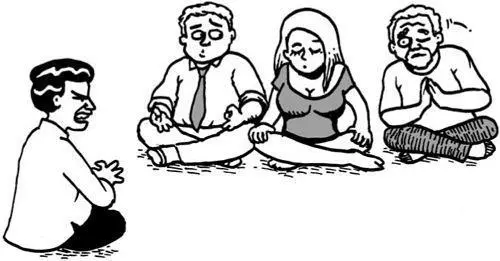Tan, Chade-Meng - Search Inside Yourself - The Unexpected Path to Achieving Success, Happiness (and World Peace)
Здесь есть возможность читать онлайн «Tan, Chade-Meng - Search Inside Yourself - The Unexpected Path to Achieving Success, Happiness (and World Peace)» — ознакомительный отрывок электронной книги совершенно бесплатно, а после прочтения отрывка купить полную версию. В некоторых случаях можно слушать аудио, скачать через торрент в формате fb2 и присутствует краткое содержание. Год выпуска: 2012, Издательство: Harper Collins, Inc., Жанр: Старинная литература, на английском языке. Описание произведения, (предисловие) а так же отзывы посетителей доступны на портале библиотеки ЛибКат.
- Название:Search Inside Yourself: The Unexpected Path to Achieving Success, Happiness (and World Peace)
- Автор:
- Издательство:Harper Collins, Inc.
- Жанр:
- Год:2012
- ISBN:нет данных
- Рейтинг книги:4 / 5. Голосов: 1
-
Избранное:Добавить в избранное
- Отзывы:
-
Ваша оценка:
- 80
- 1
- 2
- 3
- 4
- 5
Search Inside Yourself: The Unexpected Path to Achieving Success, Happiness (and World Peace): краткое содержание, описание и аннотация
Предлагаем к чтению аннотацию, описание, краткое содержание или предисловие (зависит от того, что написал сам автор книги «Search Inside Yourself: The Unexpected Path to Achieving Success, Happiness (and World Peace)»). Если вы не нашли необходимую информацию о книге — напишите в комментариях, мы постараемся отыскать её.
Search Inside Yourself: The Unexpected Path to Achieving Success, Happiness (and World Peace) — читать онлайн ознакомительный отрывок
Ниже представлен текст книги, разбитый по страницам. Система сохранения места последней прочитанной страницы, позволяет с удобством читать онлайн бесплатно книгу «Search Inside Yourself: The Unexpected Path to Achieving Success, Happiness (and World Peace)», без необходимости каждый раз заново искать на чём Вы остановились. Поставьте закладку, и сможете в любой момент перейти на страницу, на которой закончили чтение.
Интервал:
Закладка:
Relaxed and Alert at the Same Time
The big secret of meditation, at least at the beginning stage, is it gets you to a state where your mind is relaxed and alert at the same time.
When your attention and meta-attention both become strong, something interesting happens. Your mind becomes increasingly focused and stable, but in a way that is relaxing. It is like balancing a bicycle on easy terrain. With enough practice, it becomes almost effortless and you get the experience of moving forward and being relaxed at the same time. You get where you need to be, and you actually enjoy the experience of getting there because it is relaxing.
With enough practice, you may even become able to bring your mind to that state on demand and stay in it for a prolonged period of time. When the mind becomes highly relaxed and alert at the same time, three wonderful qualities of mind naturally emerge: calmness, clarity, and happiness.
Here is the analogy. Imagine you have a pot of water full of sediments, and imagine that pot is constantly shaken and agitated. The water appears cloudy. Imagine that you stop agitating the pot and just let it rest on the floor. The water will become calm and, after a while, all the sediments will settle and the water will appear clear. This is the classical analogy of the mind in the alert and relaxed state. In this state, we temporarily stop agitating the mind the same way we stop agitating the pot. Eventually, our mind becomes calm and clear, the same way the water appears calm and clear.
Happiness Is the Default State of Mind
There is an extremely important quality of mind in the calm and clear state that is not captured by the above analogy. That quality is happiness. When the mind is calm and clear at the same time, happiness spontaneously arises. The mind becomes spontaneously and naturally joyful!
But why? Even after I found myself able to access that mind on demand, it did not make a lot of sense to me. Why should a calm and clear mind automatically be happy? I put that question to my friend Alan Wallace, one of the Western world’s top experts in the practice of relaxed concentration (a practice known as shamatha ).
Alan said the reason is very simple: happiness is the default state of mind.So when the mind becomes calm and clear, it returns to its default, and that default is happiness. That is it. There is no magic; we are simply returning the mind to its natural state.

Happiness is the Default State of Mind
Alan, in his deep wisdom, said that in his usual calm, joyful, and understated manner. But to me, that statement represents a simple yet deeply profound, life-changing insight. It implies that happiness is not something that you pursue; it is something you allow. Happiness is just being. That insight changed my life.
To me, the biggest joke is that after all that has been done in the history of the world in the pursuit of happiness, it turns out that sustainable happiness is achievable simply by bringing attention to one’s breath. Life is funny. At least my life is.
Meditation Is like Exercise
The traditional analogy of the pot of water filled with sediments is at least 2,600 years old. There is another analogy for meditation, which modern people may understand better, and that is the analogy of physical exercise. Meditation is exercise for the mind.
When you go to the gym, you are training your body so that it can gain more physical abilities. If you lift weights, you will eventually become stronger. If you regularly jog, your times will be faster and you will be able to run farther. In the same way, meditation is like training your mind so that it can gain more mental abilities. For example, if you do a lot of meditation exercises, your mind becomes calmer and more perceptive, you can focus your attention more strongly and for longer, and so on.
I joke that meditation is like sweating at the gym, minus the sweating, and the gym.

One important similarity between exercise and meditation is that, in both cases, growth comes from overcoming resistance. For example, when you are weight training, every time you flex your biceps in resistance to the weight of dumbbells, your bicep muscles grow a little bit stronger. The same process happens during meditation. Every time your attention wanders away from your breath and you bring it back, it is like flexing your biceps—your “muscle” of attention grows a bit stronger.
The implication of this insight is that there is no such thing as a bad meditation. For many of us, when we meditate, we find our attention wanders away from our breath a lot, and we keep having to bring it back, and then we think we’re doing it all wrong. In fact, this is a good exercise because every time we bring a wandering attention back, we are giving our muscles of attention an opportunity for growth.
A second similarity between exercise and meditation is they can both significantly change the quality of your life. If you never exercise and you put yourself on a regular exercise regime, a few weeks or months later, you may find many significant changes in yourself. You will have more energy, you can get more stuff done, you get sick less often, you look better in the mirror, and you just feel great about yourself. The same is true for meditation. After a few weeks or months of starting a regular meditation regime, you have more energy; your mind becomes calmer, clearer, and more joyful; you get sick less; you smile more; your social life improves (because you smile more); and you feel great about yourself. And you don’t even need to sweat.
Practice of Mindfulness Meditation
PROCESS MODEL OF MINDFULNESS MEDITATION
The process of mindfulness meditation is quite simple, as illustrated in the following diagram.

The process starts with an intention.Start by creating an intention, a reason for wanting to abide in mindfulness. Perhaps it is to reduce stress. Perhaps it is to increase your own well-being. Maybe you want to cultivate your emotional intelligence for fun and profit. Or maybe you just want to create the conditions for world peace, or something.
In fact, if you are really lazy, or really busy, or really both, you can declare your meditation done right here. The act of creating good intentions is itself a form of meditation. Every time you create an intention, you are subtly forming or reinforcing a mental habit. If you create that same intention a lot, it eventually becomes a habit that will keep arising in your mind in varied situations to guide your behavior. For example, if many times a day you create the intention of caring for your own well-being, then after a while, in every situation you are in or with every decision you make, you may find yourself (perhaps unconsciously) biasing everything you do toward actions or decisions that increase well-being, and because of that, your well-being may actually improve.
This is even more powerful when your intention is toward the well-being of others. Just by forming that intention a lot, and not doing anything else, you may find yourself gradually (and, again, sometimes unconsciously) becoming kinder and nicer to other people. Pretty soon, many more people may like you and want to hang out with you, and you may not even know why—you may just think they are attracted to your good looks.
Читать дальшеИнтервал:
Закладка:
Похожие книги на «Search Inside Yourself: The Unexpected Path to Achieving Success, Happiness (and World Peace)»
Представляем Вашему вниманию похожие книги на «Search Inside Yourself: The Unexpected Path to Achieving Success, Happiness (and World Peace)» списком для выбора. Мы отобрали схожую по названию и смыслу литературу в надежде предоставить читателям больше вариантов отыскать новые, интересные, ещё непрочитанные произведения.
Обсуждение, отзывы о книге «Search Inside Yourself: The Unexpected Path to Achieving Success, Happiness (and World Peace)» и просто собственные мнения читателей. Оставьте ваши комментарии, напишите, что Вы думаете о произведении, его смысле или главных героях. Укажите что конкретно понравилось, а что нет, и почему Вы так считаете.







![Chade-Meng Tan - Search Inside Yourself - Increase Productivity, Creativity and Happiness [ePub edition]](/books/703803/chade-thumb.webp)



